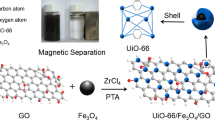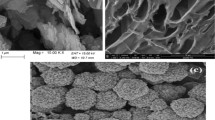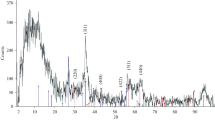Abstract
The work demonstrates a new greener approach in developing bio-composite magnetic nanoparticles (Fe3O4@PBP) containing a sorbent extracted from papaya (Carica papaya) bark for efficient uranium (VI) sorption from aqueous media. The findings showed that Fe3O4@PBP nano composites exhibited a characteristic average size of around 26.4 nm, as inferred from the XRD data. Further, these nano composite performed well in the uptake of uranium (VI), revealing the removal efficiency and the maximum adsorption capacity to be 88.8% and 120.48 mg/g, respectively. The thermodynamic investigation indicated that the endothermic uranium(VI) uptake sorption process by expeditious Fe3O4@PBP nano composite is naturally impulsive.
Graphic abstract












Similar content being viewed by others
References
Liu N, Li C, Bai J, Liang H, Gao Q, Wang N, Guo R, Qin Z, Zunli M (2021) A high-capacity amidoxime-functionalized magnetic composite for selective uranium capture in salt lake water. J Environ Chem Eng. https://doi.org/10.1016/j.jece.2021.106688
Bjørklund G, Semenova Y, Pivina L, Dadar M, Rahman MM, Aaseth J, Chirumbolo S (2020) uranium in drinking water: a public health threat. Arch Toxicol. https://doi.org/10.1007/s00204-020-02676-8
WHO (2011) Guidelines for drinking water quality. 4th ed. WHO Press: Geneva, Switzerland
Tuzen M, Saleh TA, Sar A, Sar N (2020) Interfacial polymerization of trimesoyl chloride with melamine and palygorskite for efficient uranium ions ultra-removal. Chem Eng Res Des. https://doi.org/10.1016/j.cherd.2020.04.034
Saleh TA, Naeemullah Tuzen M, Ahmet S (2017) Polyethylenimine modified activated carbon as novel magnetic adsorbent for the removal of uranium from aqueous solution. Chem Eng Res Des. https://doi.org/10.1016/j.cherd.2016.10.030
Wang Z, Hu H, Huang L, Lin F, Liu S, Wu T, Wang X, Rabah SO, Lu Y, Wang X (2020) Graphene aerogel capsulated precipitants for high efficiency and rapid elimination of uranium from water. Chem Eng J. https://doi.org/10.1016/j.cej.2020.125272
Tapia-Rodriguez A, Luna-VelascoA FJA, Sierra-Alvarez R (2010) Anaerobic bioremediation of hexavalent uranium in groundwater by reductive precipitation with methanogenic granular sludge. Water Res. https://doi.org/10.1016/j.watres.2009.12.030
He M, Wang L, Zhang Z, Zhang Y, Zhu J, Wang X, Miao R, Miao R (2020) Stable forward osmosis nanocomposite membrane doped with sulfonated graphene oxide@metal–organic frameworks for heavy metal removal. ACS Appl Mater Interfaces. https://doi.org/10.1021/acsami.0c17405
Cecal A, Humelnicu D, Rudic V, Cepoi L, Ganju D, Cojocari A (2012) Uptake of uranyl ions from uranium ores and sludges by means of spirulina platensis, porphyridium cruentum and nostok linckia alga. Bioresour Technol. https://doi.org/10.1016/j.biortech.2012.05.053
Tan L, Zhang X, Liu Q, Jing X, Liu J, Song D, Wang J, Liu L, Wang J (2015) Synthesis of Fe3O4@TiO2 core–shell magnetic composites for highly efficient sorption of uranium(VI). Colloids Surf A. https://doi.org/10.1016/j.colsurfa.2015.01.040
Yu B, Xu J, Liu JH, Yang ST, Luo J, Zhou Q, Liu Y, Liao R, Wang H, Liu Y (2013) Adsorption behavior of copper ions on graphene oxide–chitosan aerogel. J Environ Chem Eng. https://doi.org/10.1016/j.jece.2013.08.017
Duan X, Zhang C, Srinivasakannan C, Wang X (2017) Waste walnut shell valorization to iron loaded biochar and its application to arsenic removal. Resour-Effic Technol 3:29–36
Han C, Li H, Pu H, Yu H, Deng L, Huang S, Luo Y (2013) Synthesis and characterization of mesoporous alumina and their performances for removing arsenic (V). Chem Eng J 217:1–9
Ren Z, Zhang G, Paul Chen J (2011) Adsorptive removal of arsenic from water by an iron-zirconium binary oxide adsorbent. J Colloid Interface Sci 358:230–237
Ungureanu G, Santos S, Boaventura R, Botelho C (2015) Arsenic and antimony in water and wastewater: overview of removal techniques with special reference to latest advances in adsorption. J Environ Manage 151:326–342
Mohan D, Pittman CU (2007) Arsenic removal from water/ wastewater using adsorbents-a critical review. J Hazard Mater 142:1–53
Kausar A, Bhatti HN (2013) Adsorptive removal of uranium from wastewater: a review. J Chem Soc Pakistan 35(3):1041–1052
Mohan D, Sarswat A, Singh VK, Alexandre-Franco M, Pittman CU (2011) Development of magnetic activated carbon from almond shells for trinitrophenol removal from water. Chem Eng J 172:1111–1125
Kashyap Agarwal A (2019) Removal of salicylic acid from aqueous solutions by magnetic bio sorbent synthesized from pineapple peel. J Pharm Innov 8:502–504
Dick G (2003) Papaya: A tantalising taste of the tropics. maricopa county master gardener volunteer information, University of Arizona Cooperative Extension
Shaik Basha ZVP, Murthy Jha B (2008) Sorption of Hg (II) from aqueous solutions onto carica papaya: application of isotherms. Ind Eng Chem Res 47:980–986
Saeed A, Akhter MW, Iqbal M (2005) Removal and recovery of heavy metals from aqueous solution using papaya wood as a new biosorbent. Sep Purif Technol. https://doi.org/10.1016/j.seppur.2005.02.004
Li X, Xu H, Chen ZS, Chen G (2011) Biosynthesis of NPs by microorganisms and their applications. J Nanomater. https://doi.org/10.1155/2011/270974
Naeem H, Bhattia HN, Sada S, Iqbal M (2017) Uranium remediation using modified vigna radiata waste biomass. Appl Radiat Isot 123:94–101
Igwegbe WE, Okoro BC, Osuagwu JC (2015) Use of carica papaya as a bio- sorbent for removal of heavy metals in waste water. Int Scholarly Sci Res Innov 9(12):1400–1404
Daoush WM (2017) Co-precipitation and magnetic properties of magnetite nanoparticles for potential biomedical applications. J Nanomed Res 5(3):1–12
Srivastava PK (2016) Spectrophotometric analysis of underground well water uranium of an abondon coal mines. IOSR J Environ Sci Toxicol Food Technol 10:101–105
Yuan Y, Liu N, Dai Y, Wang B, Liu Y, Chen C, Huang D (2020) Effective biosorption of uranium from aqueous solution by cyanobacterium anabaena flos-aquae. Environ Sci Pollut Res Int 27(35):44306–44313
Wang S, Guo W, Gao F, Wang Y, Gaoc Y (2018) Lead and uranium sorptive removal from aqueous solution using magnetic and nonmagnetic fast pyrolysis rice husk biochars. RSC Adv 8:13205–13217
Yu A, Wang J, Jiang Y (2016) Removal of uranium from aqueous solution by alginate beads. Jing Nucl Eng Technol 49:534–540
Rengaraj S, Moon SH, Sivabalan R, Arabindoo B, Murugesan V (2002) Removal of phenol from aqueous solution and resin manufacturing industry wastewater using an agricultural waste: Rubber seed coat. J Hazard Mater 89(2–3):185–196
Hanif MA, Nadeem R, Bhatti HN, Ahmad NR, Ansari TM (2007) Ni (II) bio sorption by Cassia fistula (Golden Shower) biomass. J Hazard Mater 139:345–355
Zubair A, Bhatti HN, Hanif MA, Shafqat F (2008) Kinetic and equilibrium modeling for Cr(III) and Cr(VI) removal from aqueous solutions by citrus reticulate waste biomass. Wat Air Soil Pollut 191:305–318
Saleem N, Bhatti HN (2011) Adsorptive removal and recovery of U (VI) by citrus waste biomass. Bio Resources. https://doi.org/10.15376/biores.6.3.2522-2538
Kausar A, Bhatti HN (2013) Adsorptive removal of uranium from wastewater: a review. J The Chem Soc Pak 35(3):1041–1052
Nuhanović M, Grebo M, Draganović S, Memić M, Smječanin N (2019) Uranium (VI) biosorption by sugar beet pulp: equilibrium, kinetic and thermodynamic studies. J Radioanal Nucl Chem 322(3):2065–2078
Šabanović E, Muhić-Šarac T, Nuhanović M, Memić M (2019) Biosorption of uranium (VI) from aqueous solution by Citrus limon peels: kinetics, equlibrium and batch studies. J Radioanal Nucl Chem 319(1):425–435
Velizar S, Dragana B, Milan G, Bogdanović G (2009) Heavy metal ions adsorption from mine waters by sawdust. Chem Ind Chem Eng. https://doi.org/10.2298/CICEQ0904237S
Iqbal MA, Saeed Zafar SI (2009) FTIR spectrophotometry, kinetics and adsorption isotherms modeling, ion exchange, and EDX analysis for understanding the mechanism of Cd2+ and Pb2+ removal by mango peel waste. J Hazard Mater 164:161–171
Anwar J, Shafique U, Waheed Z, Salman M, Dar A, Anwar S (2010) Removal of Pb (II) and Cd (II) from water by adsorptionon peels of banana. Bioresource Technol 101:1752–1755
Langmuir I (1918) The adsorption of gases on plane surfaces of glass, mica, and platinum. J Am Chem Soc 40:1361–1368
Freundlich H (1906) Adsorption in solution Phys Chem Soc 40:1361–1368
Araújo CS, Almeida IL, Rezende HC, Marcionilio SM, Léon JJ, de Matos TN (2018) Elucidation of mechanism involved in adsorption of Pb (II) onto lobeira fruit (solanum lycocarpum) using langmuir, freundlich and temkin isotherms. Microchem J. https://doi.org/10.1016/j.microc.2017.11.009
Esfandiari B, Monajjemi M (2013) Physical adsorption between mono and diatomic gases inside of carbon nanotube with respect to potential energy. J Phys Theor Chem 10:31–42
Lagergren S (1898) Zur theorie der sogenannten adsorption geloster stoffe”, kungligasvenska vetenkapsakademiens. Handlinger. https://doi.org/10.1007/BF01501332
Blanchard G, Maunaye M, Martin G (1984) Removal of heavy metals from waters by means of natural zeolites. Water Res 18:1501–1507
Weber WJ, Morris JC (1963) Kinetics of adsorption on carbon solution. J Sanit Eng Div A Soc Civil Eng 89:31–35
Pan M, Lin X, Xie J, Huang X (2017) Kinetic, equilibrium and thermodynamic studies for phosphate adsorption on aluminum hydroxide modified palygorskite nano-composites. RSC Adv 7(8):4492–4500
Liu Y, Liu YJ (2008) Biosorption isotherms, kinetics and thermodynamics. Sep Purif Technol 61(3):229–242
Yin X, Bai J, Fan F, Cheng W, Tian W, Wang Y, Zhi Qin Z (2015) Amidoximed silica for uranium (VI) sorption from aqueous solution. J Radioanal Nucl Chem. https://doi.org/10.1007/s10967-014-3652
Adeogun A, Akande J, Idowu M, Kareem S (2019) Magnetic tuned sorghum husk biosorbent for effective removal of cationic dyes from aqueous solution: isotherm, kinetics, thermodynamics and optimization studies. Appl Water Sci 9:1–17
Cheng Y, Li F, Liu N, Lan T, Yang Y, Zhang T, Qing R (2021) A novel freeze-dried natural microalga powder for highly efficient removal of uranium from wastewater. Chemosphere. https://doi.org/10.1016/j.chemosphere.2021.131084
Yang A, Yang P, Huang CP (2017) Preparation of graphene oxide–chitosan composite and adsorption performance for uranium. J Radioanal Nucl Chem. https://doi.org/10.1007/s10967-017-5329-4
Schierz A, Zänker H (2009) Aqueous suspensions of carbon nanotubes: surface oxidation, colloidal stability and uranium sorption. Environ Pollut. https://doi.org/10.1016/j.envpol.2008.09.045
Zou W, Bai H, Zhao L, Li K, Han R (2011) Characterization and properties of zeolite as adsorbent for removal of uranium (VI) from solution in fixed bed column. J Radioanal Nucl Chem. https://doi.org/10.1007/s10967-011-1026-x
Stopa LCB, Yamaura M (2010) Uranium removal by chitosan impregnated with magnetite nanoparticles: adsorption and desorption. Int J Nucl Energy Sci and Technol. https://doi.org/10.1504/IJNEST.2010.035538
Liu F, Wang A, Xiang M, Hu Q, Hu B (2022) Effective adsorption and immobilization of Cr (VI) and U (VI) from aqueous solution by magnetic amine-functionalized SBA-15. Sep Purif Technol. https://doi.org/10.1016/j.seppur.2021.120042
Liu L, Lin X, Li M, Chu H, Wang H, Xie Y, Luo X, Liu M, Liang L, Gong H (2021) Microwave-assisted hydrothermal synthesis of carbon doped with phosphorus for uranium (VI) adsorption. J Radioanal Nucl Chem. https://doi.org/10.1007/s10967-020-07453-6
Acknowledgements
The authors would like to acknowledge the Principal of BIT Durg (C.G.) for providing lab facilities. The authors are grateful to the NCNR, Pt.R.S.U. Raipur for offering FTIR facilities, as well as IIT Bhilai and the UGC-DAE consortium for scientific research Indore for providing SEM, EDS, and XRD facilities.
Funding
This research was not funded in any way.
Author information
Authors and Affiliations
Corresponding author
Ethics declarations
Conflict of interest
There are no relevant financial interests to disclose for the authors.
Additional information
Publisher's Note
Springer Nature remains neutral with regard to jurisdictional claims in published maps and institutional affiliations.
Rights and permissions
Springer Nature or its licensor (e.g. a society or other partner) holds exclusive rights to this article under a publishing agreement with the author(s) or other rightsholder(s); author self-archiving of the accepted manuscript version of this article is solely governed by the terms of such publishing agreement and applicable law.
About this article
Cite this article
Deshmukh, P., Sar, S.K., Jindal, M.K. et al. Magnetite based green bio composite for uranium exclusion from aqueous solution. J Radioanal Nucl Chem 332, 297–310 (2023). https://doi.org/10.1007/s10967-022-08723-1
Received:
Accepted:
Published:
Issue Date:
DOI: https://doi.org/10.1007/s10967-022-08723-1




